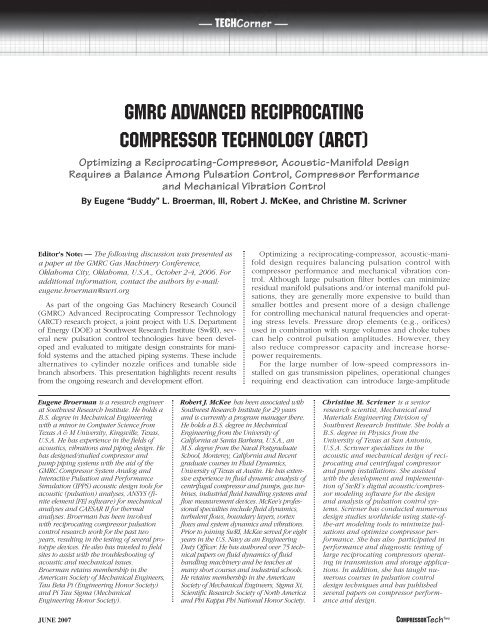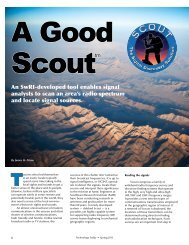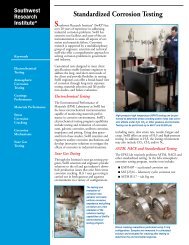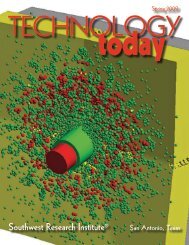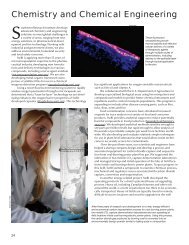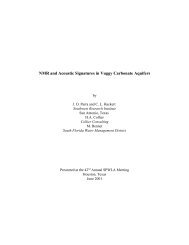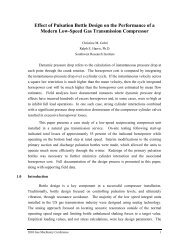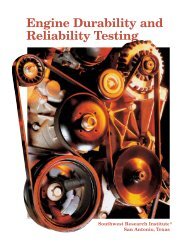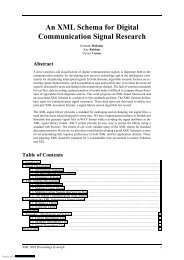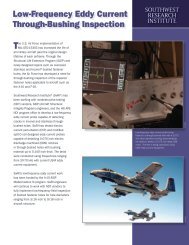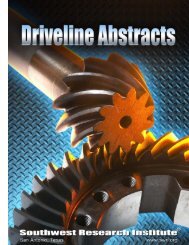gmrc advanced reciprocating compressor technology - Southwest ...
gmrc advanced reciprocating compressor technology - Southwest ...
gmrc advanced reciprocating compressor technology - Southwest ...
Create successful ePaper yourself
Turn your PDF publications into a flip-book with our unique Google optimized e-Paper software.
GMRC ADVANCED RECIPROCATING<br />
COMPRESSOR TECHNOLOGY (ARCT)<br />
Optimizing a Reciprocating-Compressor, Acoustic-Manifold Design<br />
Requires a Balance Among Pulsation Control, Compressor Performance<br />
and Mechanical Vibration Control<br />
By Eugene “Buddy” L. Broerman, III, Robert J. McKee, and Christine M. Scrivner<br />
Editor’s Note: — The following discussion was presented as<br />
a paper at the GMRC Gas Machinery Conference,<br />
Oklahoma City, Oklahoma, U.S.A., October 2-4, 2006. For<br />
additional information, contact the authors by e-mail:<br />
eugene.broerman@swri.org<br />
As part of the ongoing Gas Machinery Research Council<br />
(GMRC) Advanced Reciprocating Compressor Technology<br />
(ARCT) research project, a joint project with U.S. Department<br />
of Energy (DOE) at <strong>Southwest</strong> Research Institute (SwRI), several<br />
new pulsation control technologies have been developed<br />
and evaluated to mitigate design constraints for manifold<br />
systems and the attached piping systems. These include<br />
alternatives to cylinder nozzle orifices and tunable side<br />
branch absorbers. This presentation highlights recent results<br />
from the ongoing research and development effort.<br />
Optimizing a <strong>reciprocating</strong>-<strong>compressor</strong>, acoustic-manifold<br />
design requires balancing pulsation control with<br />
<strong>compressor</strong> performance and mechanical vibration control.<br />
Although large pulsation filter bottles can minimize<br />
residual manifold pulsations and/or internal manifold pulsations,<br />
they are generally more expensive to build than<br />
smaller bottles and present more of a design challenge<br />
for controlling mechanical natural frequencies and operating<br />
stress levels. Pressure drop elements (e.g., orifices)<br />
used in combination with surge volumes and choke tubes<br />
can help control pulsation amplitudes. However, they<br />
also reduce <strong>compressor</strong> capacity and increase horsepower<br />
requirements.<br />
For the large number of low-speed <strong>compressor</strong>s installed<br />
on gas transmission pipelines, operational changes<br />
requiring end deactivation can introduce large-amplitude<br />
Eugene Broerman is a research engineer<br />
at <strong>Southwest</strong> Research Institute. He holds a<br />
B.S. degree in Mechanical Engineering<br />
with a minor in Computer Science from<br />
Texas A & M University, Kingsville, Texas,<br />
U.S.A. He has experience in the fields of<br />
acoustics, vibrations and piping design. He<br />
has designed/studied <strong>compressor</strong> and<br />
pump piping systems with the aid of the<br />
GMRC Compressor System Analog and<br />
Interactive Pulsation and Performance<br />
Simulation (IPPS) acoustic design tools for<br />
acoustic (pulsation) analyses, ANSYS (finite<br />
element [FE] software) for mechanical<br />
analyses and CAESAR II for thermal<br />
analyses. Broerman has been involved<br />
with <strong>reciprocating</strong> <strong>compressor</strong> pulsation<br />
control research work for the past two<br />
years, resulting in the testing of several prototype<br />
devices. He also has traveled to field<br />
sites to assist with the troubleshooting of<br />
acoustic and mechanical issues.<br />
Broerman retains membership in the<br />
American Society of Mechanical Engineers,<br />
Tau Beta Pi (Engineering Honor Society)<br />
and Pi Tau Sigma (Mechanical<br />
Engineering Honor Society).<br />
Robert J. McKee has been associated with<br />
<strong>Southwest</strong> Research Institute for 29 years<br />
and is currently a program manager there.<br />
He holds a B.S. degree in Mechanical<br />
Engineering from the University of<br />
California at Santa Barbara, U.S.A., an<br />
M.S. degree from the Naval Postgraduate<br />
School, Monterey, California and Recent<br />
graduate courses in Fluid Dynamics,<br />
University of Texas at Austin. He has extensive<br />
experience in fluid dynamic analysis of<br />
centrifugal <strong>compressor</strong> and pumps, gas turbines,<br />
industrial fluid handling systems and<br />
flow measurement devices. McKee’s professional<br />
specialties include fluid dynamics,<br />
turbulent flows, boundary layers, vortex<br />
flows and system dynamics and vibrations.<br />
Prior to joining SwRI, McKee served for eight<br />
years in the U.S. Navy as an Engineering<br />
Duty Officer. He has authored over 75 technical<br />
papers on fluid dynamics of fluid<br />
handling machinery and he teaches at<br />
many short courses and industrial schools.<br />
He retains membership in the American<br />
Society of Mechanical Engineers, Sigma Xi,<br />
Scientific Research Society of North America<br />
and Phi Kappa Phi National Honor Society.<br />
Christine M. Scrivner is a senior<br />
research scientist, Mechanical and<br />
Materials Engineering Division of<br />
<strong>Southwest</strong> Research Institute. She holds a<br />
B.S. degree in Physics from the<br />
University of Texas at San Antonio,<br />
U.S.A. Scrivner specializes in the<br />
acoustic and mechanical design of <strong>reciprocating</strong><br />
and centrifugal <strong>compressor</strong><br />
and pump installations. She assisted<br />
with the development and implementation<br />
of SwRI’s digital acoustic/<strong>compressor</strong><br />
modeling software for the design<br />
and analysis of pulsation control systems.<br />
Scrivner has conducted numerous<br />
design studies worldwide using state-ofthe-art<br />
modeling tools to minimize pulsations<br />
and optimize <strong>compressor</strong> performance.<br />
She has also participated in<br />
performance and diagnostic testing of<br />
large <strong>reciprocating</strong> <strong>compressor</strong>s operating<br />
in transmission and storage applications.<br />
In addition, she has taught numerous<br />
courses in pulsation control<br />
design techniques and has published<br />
several papers on <strong>compressor</strong> performance<br />
and design.<br />
JUNE 2007<br />
COMPRESSORTech Two
esidual pulsation levels. If the original pulsation filter bottle<br />
was not initially designed for end deactivation, the<br />
residual pulsations could adversely affect adjacent <strong>compressor</strong><br />
units, flow measurement and <strong>compressor</strong> performance.<br />
For modern, high-speed (and medium-speed) <strong>compressor</strong>s,<br />
nozzle resonance and manifold pressure losses<br />
reduce unit performance and efficiency and, if not accounted<br />
for properly, can result in undersizing of the driver<br />
at design time.<br />
Introduction and Background<br />
This research project was initiated in 2004 and is currently<br />
funded by GMRC and the industry. SwRI has been<br />
tasked with evaluating current acoustic design techniques<br />
and addressing areas requiring improvement. DOE cofunded<br />
the project in 2005.<br />
SwRI has developed and is currently evaluating new<br />
concepts in acoustic design <strong>technology</strong> that could improve<br />
unit operating flexibility, reduce manifold pressure drop,<br />
and allow improved control of vibration and operating<br />
stress levels.<br />
Four prototype devices have been developed through efforts<br />
to improve pulsation control <strong>technology</strong>, including the<br />
tunable side branch absorber (TSBA), the infinite length<br />
nozzle (ILN), the tapered cylinder nozzle (TCN) and the virtual<br />
orifice (VO). The TSBA addresses the reduction of low<br />
frequency piping pulsations and has broader potential. The<br />
ILN, TCN and VO address the reduction of cylinder nozzle<br />
resonance pulsations. Each of these devices is designed to<br />
minimize pulsation without incurring additional horsepower<br />
cost. Here, we present the initial results of the project pulsation<br />
control development work.<br />
Equation 1. f H = C A<br />
2π L e V<br />
f H = Helmholtz frequency, Hz<br />
C = Sound velocity, ft./sec.<br />
A = Cross-sectional area of choke tube, ft. 2<br />
L e = Effective length of choke tube, ft.<br />
V = Absorber volume, cf<br />
Although effective pulsation control has been achieved with<br />
a fixed geometry SBA, this design has limitations. For optimum<br />
reduction at low frequencies, the absorber volume can<br />
be relatively large and sometimes difficult to install in existing<br />
systems because of space constraints. Also, the fixed geometry<br />
SBA is tuned for a single frequency and can achieve satisfactory<br />
pulsation reduction only over a narrow bandwidth. For<br />
example, fixed geometry SBAs have been implemented successfully<br />
to detune first and second order acoustic piping resonances<br />
over a 60 rpm speed sweep (270 to 330 rpm).<br />
The effectiveness of the fixed geometry SBA inspired development<br />
of the TSBA. Similar to the SBA, the TSBA is<br />
composed of a choke tube that strategically connects a volume<br />
to the main gas piping. A conceptual image of the<br />
prototype is shown in Figure 2. It is equipped with a piston,<br />
which allows variability of the volume, thus making<br />
the TSBA tunable. Equation 1 shows that reducing the volume<br />
of the TSBA increases the associated resonant frequency,<br />
while increasing the volume decreases the resonant<br />
frequency.<br />
Controlling Piping Resonance — Reduced Vibration<br />
Fixed geometry side branch absorbers (SBA), or<br />
Helmholtz resonators, have been industry proven to reduce<br />
low frequency pulsations for fixed-speed machines or machines<br />
that operate over a small speed range. The physical<br />
characteristics of an SBA include the choke tube, which is<br />
strategically connected to the main gas piping, and the attached<br />
volume. Figure 1 illustrates the physical characteristics<br />
of an SBA and provides data showing its effectiveness<br />
at controlling 1x pulsations.<br />
■ Figure 2. Conceptual 3-D drawing of the tunable side branch absorber<br />
(TSBA).<br />
■ Figure 3. Conceptual<br />
3-D drawing<br />
of the TSBA<br />
installed in the<br />
RCTF.<br />
■ Figure 1. Effectiveness of a side branch absorber (SBA).<br />
As shown, a choke tube connects the volume to the main<br />
gas piping. The resonant (Helmholtz) frequency can be estimated<br />
from Equation 1. Once initially sized and located,<br />
acoustic simulation tools can then be used to verify and/or<br />
tune the SBA for optimum attenuation.<br />
JUNE 2007<br />
COMPRESSORTech Two
Conceptual drawings of the prototype TSBA installation<br />
at the SwRI <strong>reciprocating</strong> <strong>compressor</strong> test facility (RCTF) are<br />
presented in Figure 3. A span of 1 in. (2.5 cm) diameter<br />
piping connects the variable volume to the 3 in. (7.6 cm)<br />
diameter main gas piping. The RCTF <strong>compressor</strong> piping<br />
system had a lateral resonance at two times the <strong>compressor</strong><br />
running speed (2x), which was the target issue of the prototype<br />
TSBA.<br />
The prototype TSBA was installed in the RCTF, as<br />
shown in Figure 4. As previously described, the choke<br />
tube strategically attaches the variable volume to the<br />
main gas piping. Figure 5 summarizes measured pulsations<br />
over a <strong>compressor</strong> speed range of 600 to 900 rpm<br />
with and without the TSBA. The line marked with diamonds<br />
shows the piping resonance without the TSBA installed.<br />
The line marked with squares shows the characteristic<br />
pulsation spectrum (a valley with two peaks) of a<br />
TSBA tuned to a single frequency. The line marked with<br />
triangles shows the measured pressure pulsations with<br />
the TSBA manually tuned to track <strong>compressor</strong> running<br />
speed. The ability to tune the SBA enables successful operation<br />
over a wider speed range. The valley between the<br />
two peaks created by installing the TSBA is varied as the<br />
operating speed varies.<br />
■ Figure 6. Automation control software for tuning the TSBA.<br />
■ Figure 4.<br />
Prototype TSBA<br />
installed in the<br />
RCTF piping<br />
system.<br />
■ Figure 7. Measured data for uncontrolled TSBA vs. TSBA with automated<br />
control.<br />
■ Figure 5. Measured pulsation data with manual control of TSBA<br />
frequency.<br />
Automated control of the TSBA was then implemented.<br />
Temperature and <strong>compressor</strong> speed real-time inputs were<br />
JUNE 2007<br />
used to determine the initial quick tuning of the TSBA.<br />
Temperature enables a more accurate approximation of the<br />
gas sound speed — <strong>compressor</strong> speed is needed to determine<br />
the approximate frequency of 2x. The controller then<br />
fine-tunes the TSBA based on the real-time pulsations feedback.<br />
A screen shot of the software written to control the<br />
TSBA tuning is presented in Figure 6. Data recorded with<br />
the TSBA uncontrolled showed a distinct 2x lateral resonance.<br />
However, the 2x resonance peak was not noticeable<br />
with the TSBA automatically tuned by the controller system.<br />
A direct comparison of the data (Figure 7) shows that much<br />
lower pulsations are present when the TSBA is automatically<br />
controlled than when it is not controlled (and fixed at<br />
minimum volume).<br />
Pulsations were about four to 21 times lower with the<br />
TSBA installed as an integral part of the acoustically resonant<br />
piping system. The TSBA can be used successfully<br />
over wide speed ranges and in systems where operating<br />
conditions may vary significantly. The relatively simple<br />
and rugged design should make it easy to install in an existing<br />
piping system. The prototype TSBA was able to significantly<br />
reduce pulsations caused by coincidence of<br />
<strong>compressor</strong>-generated pulsations with the piping acoustic<br />
resonance.<br />
Although the data presented illustrates the effectiveness of<br />
the TSBA over a wide speed range, it is important to note<br />
that the TSBA can also be implemented over a variable<br />
range of molecular weights. Probably the single most important<br />
feature of the TSBA is that it can replace pressure drop<br />
damping (orifice installation) for reduction of low-frequency<br />
pulsations. Orifices, which are also used to effectively<br />
COMPRESSORTech Two
educe pulsations, add unwanted horsepower cost.<br />
Experimental testing has shown that residual 1x and 2x<br />
pulsations can be mitigated using a TSBA without added<br />
horsepower cost.<br />
Controlling Cylinder Nozzle Resonance — Increased<br />
Efficiency<br />
Because they occur at a relatively low harmonic, pulsations<br />
at the cylinder nozzle resonance frequency on a variable<br />
high-speed <strong>compressor</strong> are generally high amplitude.<br />
Acoustically, it would be advantageous to shorten the<br />
<strong>compressor</strong> nozzle length and raise the resonance frequency.<br />
However, shortening the nozzle increases the mechanical<br />
coupling in the nozzle region, resulting in higher<br />
stresses and the transfer of more vibration to the attached<br />
piping system. Other means of reducing nozzle pulsations<br />
are needed.<br />
Currently, variable high-speed machines most often require<br />
orifices to dampen nozzle pulsations, thereby reducing<br />
the risk of increased vibration and reducing the impact<br />
of pulsations on the cylinder performance, but resulting in<br />
added horsepower cost. Although maximum attenuation is<br />
typically achieved with the orifice located close to the volume,<br />
in most cases, the orifice is located at the cylinder<br />
flange connection so that it can be easily removed or replaced<br />
if necessary. Experimental testing has shown that<br />
the Infinite Length Nozzle (ILN), the Tapered Cylinder<br />
Nozzle (TCN), and the Virtual Orifice (VO) each provide<br />
some degree of pulsation reduction at the cylinder nozzle<br />
acoustic resonance frequency with less horsepower cost<br />
than an orifice. In some cases, the new prototypes resulted<br />
in less horsepower cost than that of the conventional nozzle<br />
originally installed.<br />
Infinite Length Nozzle<br />
The theory behind the Infinite Length Nozzle (ILN) concept<br />
is that multiple reflections (at each perforation) reduce<br />
the amplitude of the cylinder nozzle resonance.<br />
Simulation data for various perforation distributions are<br />
summarized in Figure 8. The squares plot presents the perforation<br />
distribution used for the first ILN tested in the<br />
RCTF. Notice that predicted pulsations are reduced by 62<br />
to 73% on resonance. The pulsation reduction is stated as<br />
a range because of the high and low ratio operating conditions<br />
that were modeled.<br />
■ Figure 9. Conceptual installation of the ILN in the RCTF bottle<br />
system.<br />
■ Figure 10. Different views of the ILN tested in the RCTF.<br />
projection was based on ILN simulations using a similarly<br />
sized cylinder and bottle. Photographs of the installed<br />
ILN are shown in Figure 10.<br />
Experimental data were acquired with and without the<br />
ILN installed. Without the ILN installed, measured data for<br />
the baseline low ratio case (Figure 11) showed a resonance<br />
of 11.9 psi (82 kPa) at 49 Hz. For the low ratio operating<br />
conditions with the ILN installed (Figure 12), measured data<br />
showed a resonance of 3.5 psi (24 kPa) at 39 Hz. The<br />
shape of the fourth order acoustic nozzle resonance (wide<br />
response) suggests high damping. Measured data with and<br />
without the ILN installed are tabulated for the high and low<br />
ratio cases in Figure 13. Note that the amplitude of the<br />
cylinder nozzle resonance is much lower with the ILN installed<br />
than without.<br />
■ Figure 8. Simulation results based on various ILN configurations.<br />
The first ILN prototype design installed in the RCTF<br />
had a perforation distribution along the projection that<br />
ranged from 1 to 16% of the bore area. A conceptual<br />
model of the ILN is shown in Figure 9. The length of the<br />
JUNE 2007<br />
■ Figure 11. Experimental data without ILN installed.<br />
A second ILN of similar length, but with a different perforation<br />
distribution, was installed in the RCTF. The second<br />
ILN prototype design had a perforation distribution<br />
COMPRESSORTech Two
■ Figure 12. Experimental data with ILN installed.<br />
Tapered Cylinder Nozzle<br />
The tapered cylinder nozzle (TCN) concept successfully<br />
addresses <strong>compressor</strong> nozzle resonance issues. The TCN<br />
effectively shifts the cylinder nozzle resonance to a higher<br />
frequency, reducing mechanical coupling.<br />
The prototype TCN design developed for the <strong>reciprocating</strong><br />
<strong>compressor</strong> test facility (RCTF) incorporated an 8 x<br />
4 in. (203 x 102 mm) reducing elbow followed by a 12 x<br />
8 in. (305 x 203 mm) reducer, as shown in Figure 15. The<br />
installed TCN configuration is shown in Figure 16.<br />
Experimental data with and without the TCN installed are<br />
tabulated for the high and low ratio operating conditions<br />
in Figure 17. For the low ratio operating conditions, a resonance<br />
of 7.7 psi (53 kPa) at 75 Hz was measured in the<br />
discharge cylinder nozzle. Without the TCN installed, a<br />
resonance of 11.9 psi (82 kPa) at 49 Hz was measured in<br />
the discharge cylinder nozzle. Note the much higher<br />
cylinder nozzle resonance frequency measured with the<br />
TCN installed.<br />
■ Figure 13. Correlation data with and without ILN installed.<br />
along the projection ranging from 2 to 32% of the bore<br />
area. Figure 14 compares the maximum pulsations measured<br />
for the baseline piping system to those measured<br />
with each of the two ILN prototypes installed. Pulsation<br />
measurements acquired for the first ILN are similar to<br />
those measured for the second ILN. However, what the<br />
graph does not show is the frequency shift that occurred<br />
with the second ILN. The second ILLN resulted in a 3 Hz<br />
increase in the response frequency as compared to that of<br />
the first ILN prototype.<br />
■ Figure 15. Tapered cylinder nozzle (TCN) concept for the <strong>reciprocating</strong><br />
<strong>compressor</strong> test facility (RCTF) discharge cylinder nozzle.<br />
■ Figure 14. ILN performance.<br />
In summary, key observations from evaluation of the<br />
two ILN prototypes installed at the discharge cylinder nozzle<br />
outlet included: maximum fourth order cylinder nozzle<br />
pulsations were reduced by 70% with no orifice; pressure<br />
drop was reduced by approximately 72% or more on the<br />
fourth order resonance; as a result of installing the second<br />
ILN, the pulsation amplitudes remained approximately the<br />
same while the resonant frequency increased; nonresonant<br />
second order pulsation amplitudes increased because of<br />
the distribution of the cylinder nozzle resonance over a<br />
large frequency range and the decrease in frequency of the<br />
cylinder nozzle resonance.<br />
Although not the most promising of the three concepts<br />
evaluated for controlling cylinder nozzle resonance, the ILN<br />
demonstrated potential and it was determined that further<br />
development is warranted.<br />
JUNE 2007<br />
■ Figure 16. TCN installed in place of the original RCTF discharge<br />
cylinder nozzle.<br />
■ Figure 17. RCTF correlation data with and without the TCN installed.<br />
Figure 18 illustrates the 25 Hz frequency shift in the<br />
cylinder nozzle resonance (50% increase) achieved with the<br />
TCN installed. The significant frequency shift observed in<br />
this case placed the cylinder nozzle resonance on a higher,<br />
weaker <strong>compressor</strong> harmonic.<br />
COMPRESSORTech Two
■ Figure 18. Large frequency shift observed with the TCN installed.<br />
Relative pressure drops were evaluated with and without<br />
orifice restrictions for the baseline and TCN installations.<br />
Pressure differential data were measured across the cylinder<br />
nozzle, primary bottle, choke piping and secondary bottle<br />
using the DeltaP measurement locations noted in Figure 19.<br />
Various orifice sizes were evaluated in the discharge <strong>compressor</strong><br />
nozzle at the flange locations identified in Figure<br />
19. Orifices of 2.0 and 2.5 in. (51 and 64 mm) I.D. were<br />
evaluated at the <strong>compressor</strong> cylinder flange in the baseline<br />
installation. With the TCN installed, orifices of 3.0 and 3.25<br />
in. (76 and 83 mm) I.D. were evaluated at the <strong>compressor</strong><br />
cylinder flange and at the <strong>compressor</strong> nozzle to bottle connecting<br />
flanges, respectively.<br />
■ Figure 20. Discharge system pressure drop at high ratio.<br />
Pressure drop data with and without orifices installed<br />
were acquired with the <strong>compressor</strong> operating on and off<br />
the discharge cylinder nozzle resonance. As shown in<br />
Figure 20, pressure drop was about a factor of three lower<br />
off resonance without the TCN installed due to the dynamic<br />
effects of pulsations. In addition, a 68% discharge pressure<br />
drop reduction was observed on resonance with the TCN<br />
installed (no orifices). Pressure drop was reduced by about<br />
38% with a large-bore orifice installed in conjunction with<br />
the TCN, when compared to a small-bore orifice installed in<br />
conjunction with a typical cylinder nozzle.<br />
Pulsation data were also acquired for the various configurations<br />
described at low and high compression ratios.<br />
Figure 21 summarizes the measured pulsation amplitudes<br />
for the various configurations analyzed as a percent of<br />
line pressure. Without the TCN, similar pulsations were<br />
recorded for both the low and high compression ratios.<br />
With a relatively small bore orifice installed, pulsations at<br />
high ratio (low flow) conditions were three times the<br />
pulsations at low ratio (high flow) conditions. The data<br />
show that the acoustic effectiveness of an orifice depends<br />
on the flow velocity through the orifice. In addition,<br />
a 34 to 35% reduction in cylinder nozzle resonance<br />
pulsation amplitudes was observed with the TCN installed<br />
(no orifices). Cylinder nozzle resonance pulsations<br />
were reduced by a factor of 2:1 with a large bore<br />
orifice installed in conjunction with the TCN, when compared<br />
to a small bore orifice installed in conjunction with<br />
a typical cylinder nozzle.<br />
Figure 22 summarizes the high ratio resonance data illustrated<br />
in Figures 20 and 21. The x-axis represents the discharge<br />
cylinder nozzle pulsations in percent of line pressure<br />
and the y-axis represents the system pressure drop in<br />
percent of line pressure. It is desirable to be near the origin<br />
of the graph such that the system has low pulsations and<br />
low pressure drop. The diamonds plot graphically represents<br />
the effect of pressure drop on pulsation amplitude<br />
without the TCN installed. In a similar manner, the circles<br />
plot represents the effect of pressure drop on pulsation amplitude<br />
with the TCN installed.<br />
■ Figure 19. Orifice locations and pressure drop (DeltaP) measurement<br />
locations.<br />
JULY 2007<br />
■ Figure 21. Discharge cylinder nozzle pulsations at low and high ratios.<br />
Comparing the diamonds plot from the “no orifice” test<br />
point to the “0.625 beta orifice” test point indicates that pulsations<br />
decrease significantly while pressure drop decreases<br />
only slightly. In addition to that comparison, considering<br />
the diamonds “0.5 beta orifice” test point indicates that, pulsations<br />
decrease even more; however, pressure drop increases.<br />
When comparing the line marked with diamonds<br />
to the circles data points, it is important to note that the<br />
COMPRESSORTech Two
0.75 beta orifice circles test point on the orange plot is significantly<br />
closer to the origin than the 0.5 beta orifice test<br />
point on the diamonds plot. Therefore, the pressure drops<br />
and pulsations were lower for a TCN in combination with a<br />
0.75 beta orifice as compared to a typical cylinder nozzle in<br />
combination with a 0.625 beta orifice.<br />
■ Figure 22. Discharge system cylinder nozzle pulsations and pressure<br />
drop.<br />
A promising feature of the TCN is that it reduces pulsations<br />
by shifting the cylinder nozzle resonance to a higher<br />
frequency, and most likely reducing mechanical coupling.<br />
In summary, key observations from evaluation of the TCN<br />
prototype included: the cylinder nozzle resonant frequency<br />
shifted above the fourth order with the TCN installed (50%<br />
frequency increase); maximum cylinder nozzle pulsation<br />
amplitudes were reduced by 34 to 35% with the TCN installed<br />
(no orifice); a 3.1:1 pressure drop reduction was observed<br />
with the TCN installed (no orifice); the TCN results<br />
showed lower pulsations (below 3% of line pressure) with<br />
lower pressure drop than would be required in a traditional<br />
■ Figure 23. Diagram showing<br />
VO concept, which essentially<br />
is a side branch absorber in the<br />
cylinder nozzle region.<br />
system without the TCN. (The API 618 pulsation guideline<br />
is 7% of line pressure for these operating conditions.)<br />
Virtual Orifice<br />
The Virtual Orifice (VO) is a non-intrusive, low pressure<br />
drop mechanism that successfully addresses cylinder<br />
nozzle resonance. The VO concept, illustrated in Figure<br />
23, is essentially the installation of a side branch absorber<br />
in the cylinder nozzle region. The circled objects in<br />
Figure 23 represent two possible locations for the VO on<br />
the discharge side of the cylinder. In this case, a choke<br />
tube connects a volume to the cylinder nozzle or to the<br />
valve cap. The choke tube and volume are sized such<br />
that the frequency of the VO coincides with the cylinder<br />
nozzle resonant frequency.<br />
Two prototypes (Figure 24) were developed, each connecting<br />
a volume to either the cylinder nozzle or valve cap<br />
using a short span of 1 in. (25 mm) diameter piping. A 1 in.<br />
(25 mm) full-bore valve was included in each 1 in. (25 mm)<br />
diameter pipe span, allowing data acquisition with and<br />
without each of the VOs installed. Opening or closing each<br />
valve effectively installs or uninstalls each VO. The VOs<br />
were installed in the RCTF, as shown in Figure 25.<br />
■ Figure 25. Prototype<br />
VOs installed at the cylinder<br />
nozzle and valve cap.<br />
Figure 26 shows measured data without the VO installed,<br />
with the VO installed along the cylinder nozzle, and with<br />
the VO installed at the valve cap. Since a side branch absorber<br />
is known to be more effective when located at a pulsation<br />
maximum, lower pulsations were expected with the<br />
VO installed at the valve cap. In this case, measured data<br />
showed only slightly lower pulsations with the valve cap<br />
VO installed, as compared to the cylinder nozzle VO. In<br />
general, pulsations at the 50 Hz resonance frequency were<br />
reduced by a factor of 4.5 or better with a VO installed.<br />
■ Figure 26.<br />
Measured data<br />
with and without<br />
the VO installed.<br />
■ Figure 24. A 3-D model of the<br />
prototype VOs at the cylinder<br />
nozzle and valve cap.<br />
After testing the valved prototypes, a more compact and<br />
practical design was built. A 3-D model of the design is illus-<br />
JULY 2007<br />
COMPRESSORTech Two
trated in Figure 27 and the installed VO redesign is shown in<br />
Figure 28. Also shown in Figure 28 is the measured pulsation<br />
data with the redesigned VO installed. When that data is compared<br />
with the data in Figure 26, the redesigned VO reduced<br />
the pulsations even more than that of the original VO design.<br />
■ Figure 27. A 3-D model of the redesigned VO.<br />
■ Figure 28. Measured data with the redesigned VO installed.<br />
Because the VO is relatively non-intrusive, it could eliminate<br />
the need for an orifice, and because it offers an effective<br />
means of reducing the cylinder nozzle resonance, it was determined<br />
that further development is warranted. Key features of<br />
the VO include: the cylinder nozzle resonance frequency was<br />
altered without increasing the pulsations at other orders; the<br />
VO design controlled the cylinder nozzle pulsations; reductions<br />
of 53 to 61% were observed for the peak pulsation amplitudes;<br />
reductions of 78 to 83% were observed for pulsations<br />
at the frequency of the original cylinder nozzle resonance; the<br />
VO is a relatively simple design that can be installed easily on<br />
existing low-speed and high-speed <strong>compressor</strong>s.<br />
Summary<br />
Compressor manifold design must balance several competing<br />
design objectives including reducing bottle and attached<br />
piping vibration to acceptable levels suitable for<br />
long life (low stress) and reliable operation, and reducing<br />
system pressure drop thereby increasing overall unit performance.<br />
Controlling pulsation levels throughout the system<br />
(nozzle, bottle, lateral and header) to acceptable levels<br />
while maintaining the broader objectives of reliable, efficient<br />
operation is increasingly more difficult with the<br />
higher speed, higher horsepower units currently being installed.<br />
The technologies described in this presentation<br />
have the potential to be applied to currently installed units<br />
(both low and high speed), as well as addressing the<br />
needs of future designs.<br />
The virtual orifice may eliminate the need for a pressure<br />
drop element in the nozzle region of many future designs.<br />
Tunable SBAs (TSBAs) can expand the operating window<br />
of existing units, not designed for single-ended operation.<br />
Incorporating TSBAs into the design methodology for highspeed<br />
units may allow for future manifold designs with improved<br />
management of vibration and operating stress levels<br />
while still providing for good unit isolation and reduced<br />
system losses. ■<br />
REPRINTED FROM JUNE & JULY 2007 COMPRESSORTech Two<br />
Copyright Diesel & Gas Turbine Publications<br />
Printed in U.S.A.


